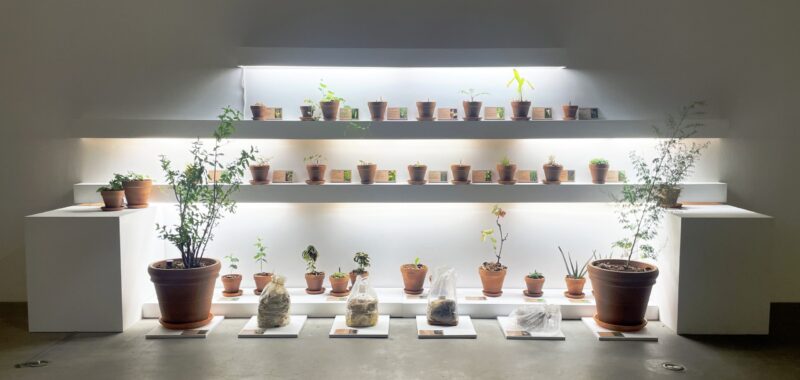LOS ANGELES — A taxidermied pigeon stands on a pedestal in the Los Angeles Municipal Art Gallery. Its wings are outstretched and a tiny backpack is strapped onto its body. The bird — or one like it — was once a scientist.
The artist Beatriz da Costa collaborated with homing pigeons for her project “PigeonBlog” (2006–08). She wanted to measure air pollution levels across Los Angeles, as she suspected that the stationary infrastructure recording data, often built atop hillsides in less-populated areas, obscured the dirtier reality for people in dense neighborhoods. With the help of pigeon fancier (i.e. someone who keeps the bird as a pet) Bob Matsuyama and a couple of engineers, da Costa sent the animal to infiltrate communities all across Los Angeles. The birds carried air pollution monitors on their backs, sending real-time data to a website. As da Costa expected, the numbers showed that low-income neighborhoods, which are squeezed under overpasses, dotted with oil wells, or laid out beneath LAX’s flight path, faced higher pollution levels than their wealthier counterparts.
Da Costa’s blend of art, engineering, and biology represents the “(Un)disciplinary Tactics” featured in her eponymous solo exhibition, curated by Daniela Lieja Quintanar with Ana Briz and organized by Los Angeles Contemporary Exhibitions as part of the Getty Pacific Standard Time: Art + Science Collide initiative. The artist, who shaped the now-shuttered Arts, Computation, Engineering (ACE) program at the University of California, Irvine, could never be pinned down to just one field of study. Throughout her career, she collaborated with scientists, doctors, and animals, blurring the boundaries between art projects and scientific experiments.

Much of da Costa’s work centered around health and wellness. While “PigeonBlog” focused on the general public, da Costa made many personal works about cancer; she battled non-Hodgkins lymphoma in her youth, and in 2009, she was diagnosed with stage IV metastatic breast cancer, which would eventually take her life at age 38. The final fight brought about a number of works, collated into a series called The Cost of Life (2009–12), which da Costa labored over until her death.
When I visited this exhibition, I anticipated that my love for pigeons would keep my criticism focused on the animal collaborations, which also includes a project, “Zapped!” (2004–06), that sent cockroaches with Radio Frequency Identification tags into a Walmart stockroom to wreak havoc on their inventory system. But this was my first time encountering The Cost of Life, and as a person with a disability who has spent many hours in doctor’s offices, I found myself transfixed and gutted by the works in this series.
Da Costa’s “The Anti-Cancer Survival Kit” (2012–13), and her collaboration with artist Donald Daedalus, “The Life Garden” (2011), focus on medicinal plants with cancer-curing properties. “The Life Garden” displays 53 species of plants sprouting from terracotta pots and placed on shelves like library books, ready for a sick person to check out. Placards accompany each plant, detailing the scientific studies that back up ancient wisdom. Scientists have examined how an anti-inflammatory like Ashwagandha can affect the prostate, lungs, or breasts. The garden reminded me of all the natural remedies I’ve tried to cure my chronic pain: boric acid, gabapentin, probiotics, peppermint teas. Yet I found da Costa’s desire to share these plants with others, and its underlying optimism, to be alienating. My cynical self couldn’t stop thinking about how promising an anti-cancer garden was an oversell. These plants have not cured me, and they did not cure da Costa either.

Another work from the series, “Dying for the Other” (2011), moved me more. It shows how da Costa donated her still-living body to science. The video triptych juxtaposes da Costa, who volunteered for experimental treatments, struggling through physical therapy along with footage of lab rats writhing in pain. Scientists had injected the rats with breast cancer cells to study how the disease would affect a living organism — in these videos, we realize that both da Costa and the rats are dying from the same condition. The work brings up the ethics of testing on humans and animals; da Costa’s participation demonstrates that humans can also in some ways be unwilling subjects in medical studies even if not forcefully given cancer in an experiment. Anyone with breast cancer who chooses not to become a specimen, for instance, just ends up reflecting the experiment’s control subjects. By volunteering for the trials, da Costa finds agency by becoming a variable in the study.
I found a deep relation to this piece, as I participated in a five-year-long research study in my mid-20s. I allowed a doctor to crush my thumb with pressure sensors, poke dull needles into my tender points, scald my ankles in hot foot baths, and undergo Magnetic Resonance Imaging, all to help them understand the pain threshold for people with chronic pain. For those who feel helpless while they endure a disease or chronic illness, opting into a study feels like a small way to help others. Maybe doctors cannot heal us now, but becoming data points will help us cure people in the future.
Da Costa’s work was relentlessly optimistic, which was likely necessary for someone who lived a short life scored by illness. Da Costa’s mission was to fight for a better quality of life, whether it be the air we breathe or through the plants we consume; and all lives, from pigeons to humans, were precious.


Beatriz da Costa: (un)disciplinary tactics continues at the Los Angeles Municipal Art Gallery (4800 Hollywood Boulevard, Los Angeles, California) through January 5, 2025. The exhibition was organized by Daniela Lieja Quintanar and Ana Briz.

